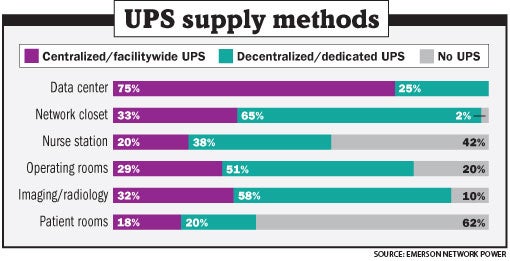IT power supply needs to grow along with computer use
 |
| A facilitywide uninterruptible power supply system like the 750 kVA Liebert NXL can prevent unplanned downtime for a hospital's IT system during power loss. |
As the use of computers and other information technology (IT) devices becomes more common in hospital clinical areas, it is critical to ensure that the power supply to those devices operates without interruption.
Rapid growth in the use of network-linked devices in patient rooms and operating suites makes unplanned IT downtimes increasingly unacceptable, says Dan Draper, manager of strategy and research for the Liebert products business of Emerson Network Power.
About one-third of hospitals surveyed by Emerson reported that they had experienced unplanned IT system downtimes. Of that group, 7 percent said patients were impacted significantly, 18 percent said patients were impacted mildly and 7 percent said patients were not impacted, according to survey results published in a white paper called "Hospital IT and Facilities Special Report" (available online at http://bit.ly/dBgMjn).
Hospitals need to take a hard look at installing uninterruptible power supply (UPS) systems to prevent unplanned downtimes from occurring in clinical areas, Draper says.
More than 60 percent of patient rooms are not supported by UPS and only 28 percent of operating rooms have emergency power receptacles serviced through a UPS, according to the survey.

"There's so much technology inside of a hospital, and it's not limited to a network closet or the computer room," says Draper. "There's IT everywhere and hospitals need to make a concerted effort to keep it up and running no matter what it is."
The most obvious concern related to unplanned IT downtimes is the potential for patient care to be delayed because staff can't access important information. "If I am a nurse or doctor and I do not have access to that digital patient record, I don't know what this patient is allergic to; I don't know what orders have been assigned to this patient. So there's a potential for a delay in care," Draper says.
Another concern is that unplanned downtimes can cause clinical staff to become frustrated with the technology that is supposed to help them improve efficiency. Consequently, they may be reluctant to use the technology.
The percentage of hospitals having experienced unplanned IT downtime is much higher than what occurs in large banks, where the number is in the single digits, says Draper.
A typical 10-second power outage without UPS can cause medical devices and computers linked to the hospital's network to take from 5 to 40 minutes to become operable again, depending on its complexity. The solution is installing either a centralized UPS or smaller dedicated UPS systems that serve as a bridge to the hospital's generator until power is restored.
There are pros and cons to both systems, says Draper. A large centralized UPS requires a high capital cost and planning because it's part of the hospital's central power plant. Distributed UPS is a lower-cost solution that can be deployed when and where needed in a new or existing hospital.
While distributed UPS is less costly than a centralized system, "the sum of the parts is much greater than the whole, making it a much more expensive route for the hospital to take" over time, he says. "But it's much quicker to deploy and you don't need an electrical engineer to redesign an electrical system."




